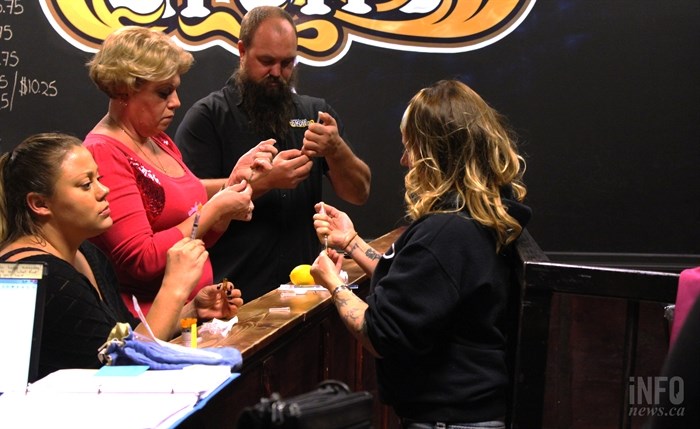
Staff members of the Blue Grotto nightclub practice injecting naloxone into a lemon.
(ASHLEY LEGASSIC / iNFOnews.ca)
October 17, 2016 - 11:30 AM
'IT'S SOMETHING WE SEE EVERY DAY'
KAMLOOPS - The overdose death of Edmond Paul Adkin of Kamloops made headlines earlier this month after he took fentanyl-laced cocaine at a Kelowna wedding.
His name belongs to a seeminly never ending list of young people who have died from fentanyl overdoses within the past year.
Adkin had friends who work at the Blue Grotto in downtown Kamloops and instead of taking his death as simply a cautionary tale, they decided to step up to do their part.
Co-owners Kathy and Teri Willey were also inspired when they saw iNFOnews.ca’s story about a Kamloops mother who lost her son to a fentanyl overdose. She started a campaign asking downtown businesses to have naloxone kits.
Kathy got in touch with Kira Haug from ASK Wellness, a local society that provides support for homeless and/or drug addicted clients. Haug was ecstatic at the opportunity to inform nightclub staff about the life-saving opioid reverser.
A training session was held last Thursday, Oct. 13 to deliver naloxone kits to the bar and teach some of the employees how to use them. It’s something they hope they never have to use, but realize it's a possibility in an area that frequently sees open drug use.
“I hope not,” Kathy says, “(but) we’re right downtown so it’s something we see everyday.”
Haug says this is an opportunity to put a face on addiction and drug use.
“Whatever the issue, I try to build a bridge of understanding,” Haug says.
She says it’s important for businesses, especially nightclubs, to know how to administer a naloxone shot and keep someone alive for as long as possible.
Naloxone acts as a barrier for opioids when someone is overdosing. Haug says it “hides overdose symptoms" by interrupting the drug affecting the nervous system. The problem is it doesn’t actually stop the overdose. It could take several shots of naloxone to fully wake someone up from their overdose.
"SAVE ME"
The steps for administering naloxone to someone can be summed up in six steps, abbreviated as SAVE ME:
-
Stimulate: When you first realize someone is experiencing an opioid overdose, the first thing you want to do is stimulate them. That can be done by making a fist and rubbing their sternum or lips. You’ll want to speak to this person directly while you’re doing it. Stimulation is used to confirm someone is unconscious. If the pain doesn’t snap them out of it, you’ll proceed with the rest of the steps to keep them alive. Haug says the most important step to take if the person is unconscious is to call 911.
-
Airway: Open up the person’s airway by tilting their head back. Clear out anything that may be in their mouth.
-
Ventilate: Start giving the person one breath every five seconds. “That breath is going to save somebody’s life,” Haug says. She stresses the importance of first aid kits being equipped with ventilation masks so there’s no hesitation in giving a person mouth-to-mouth.
-
Evaluate: Once you’ve completed the first three steps, evaluate the person to see if they are still unresponsive. If they are, you’ll give them one shot of naloxone.
-
Muscular injection: When you give someone the injection, you’ll want to aim for a body part with a large amount of muscle. This can be the thighs, butt or biceps.
-
Evaluate: You’ll need to perform another evaluation after you administer the first shot of naloxone. It can take anywhere from two to 15 minutes for the medication to kick in. But if the person doesn’t respond within the first three minutes, administer another shot. You can’t overdose on naloxone.
Haug told the bar owners they would probably never have to use the kits, but if the time does come they’ll be prepared for it. She advises all bar owners to look into any drugs they find in their clubs so they know what’s coming in and what to expect. Haug says if someone is overdosing, question anyone around them to find out what happened and what drugs were taken in the past few hours.
“Use your environment,” Haug says.
For more information on naloxone training, go here.
To contact a reporter for this story, email Ashley Legassic or call 250-319-7494 or email the editor. You can also submit photos, videos or news tips to the newsroom and be entered to win a monthly prize draw.
We welcome your comments and opinions on our stories but play nice. We won't censor or delete comments unless they contain off-topic statements or links, unnecessary vulgarity, false facts, spam or obviously fake profiles. If you have any concerns about what you see in comments, email the editor in the link above.
News from © iNFOnews, 2016